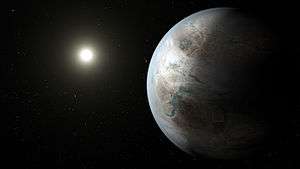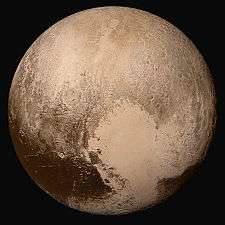Kepler-438b
| Exoplanet | List of exoplanets | |
|---|---|---|
 | ||
| Parent star | ||
| Star | Kepler-438 | |
| Constellation | Lyra[2] | |
| Right ascension | (α) | 18h 46m 35.000s |
| Declination | (δ) | +41° 57′ 3.93″ |
| Apparent magnitude | (mV) | 14.467 |
| Distance | 470[2] ly (145 pc) | |
| Spectral type | M?V | |
| Mass | (m) | 0.544+0.06 −0.04 M☉ |
| Radius | (r) | 0.52+0.06 −0.04 R☉ |
| Temperature | (T) | 3748 (± 112) K |
| Metallicity | [Fe/H] | 0.16 (± 0.14) |
| Age | 4.4+0.8 −0.7[3] Gyr | |
| Physical characteristics | ||
| Mass | (m) | 1.3+2.6 −0.7 M⊕ |
| Radius | (r) | 1.12 (± 0.16) R⊕ |
| Stellar flux | (F⊙) | 1.40+0.67 −0.77 ⊕ |
| Temperature | (T) | 276 K (3 °C; 37 °F) |
| Orbital elements | ||
| Semi-major axis | (a) | 0.16600 AU |
| Eccentricity | (e) | 0.03+0.01 −0.03[3] |
| Orbital period | (P) | 35.23319 d |
| Inclination | (i) | 89.860° |
| Discovery information | ||
| Discovery date | 2015[4] | |
| Discoverer(s) | Kepler spacecraft | |
| Discovery method | Transit | |
| Discovery status | Published refereed article | |
| Other designations | ||
| KOI-3284.01; Kepler-438 b; KOI-3284 b; K03284.01; WISE J184634.98+415704.0 b; KIC 6497146 b; 2MASS J18463499+4157039 b | ||
| Database references | ||
| Extrasolar Planets Encyclopaedia | data | |
| SIMBAD | data | |
| Exoplanet Archive | data | |
| Open Exoplanet Catalogue | data | |
Kepler-438b (also known by its Kepler Object of Interest designation KOI-3284.01) is a confirmed near-Earth-sized exoplanet, likely rocky, orbiting on the inner edge of the habitable zone of the red dwarf as it receives 1.4 times our solar flex.[5] Kepler-438, about 470 light-years (145 parsecs, or nearly 4.5×1015 km) from Earth in the constellation Lyra.[1][2] The planet was discovered by NASA's Kepler spacecraft using the transit method, in which the dimming effect that a planet causes as it crosses in front of its star is measured. NASA announced the confirmation of the exoplanet on 6 January 2015.[1] Although it is not habitable, as of June 2015, it has the highest index on the Earth Similarity Index, with a rating of 0.88.[6]
Kepler-438b is approximately 470 light years from Earth, so travelling there is presently impossible within a human lifetime. The German-designed Helios probes, notable for having set the current speed record among spacecraft at 252,792 km/h, would take some two million years to travel to Kepler-438b.[7]
Characteristics
Mass, radius and temperature
Kepler-438b is an Earth-sized planet, an exoplanet that has a mass and radius close to that of Earth. It has a radius of 1.12 R⊕, and a mass of 1.3 M⊕. It has an equilibrium temperature of 276 K (3 °C; 37 °F), close to that of Earth.
Host star
The planet orbits a (M-type) red dwarf star named Kepler-438. The star has a mass of 0.54 M☉ and a radius of 0.52 R☉, both lower than those of the Sun by almost half. It has a surface temperature of 3748 K and is estimated to be about 4.4 billion years old,[3] only 200 million years younger than the Sun.[8] and the Sun has a surface temperature of 5778 K.[9]
The star's apparent magnitude, or how bright it appears from Earth's perspective, is 14.467. Therefore, it is too dim to be seen with the naked eye.
Orbit
Kepler-438b orbits its parent star once every 35.2 days.[1][2] It is likely tidally locked due to its close distance to its star.[10]
Habitability

The planet was announced as orbiting within the habitable zone of Kepler-438, a region where liquid water could exist on the surface of the planet. In the Earth Similarity Index (ESI), which measures how similar are planets to Earth as to physics and chemistry, with 1.00 being the most similar, Kepler-438b has an index of 0.88, the highest known to date, making it currently the most Earth-like planet in terms of radius and stellar flux.[1][2] However it has been found that this planet is subjected to powerful radiation activity from its parent star every 100 days, much more violent storms than the stellar flares emitted by the Sun and which would be capable of sterilizing life on Earth.[11]
Researchers at the University of Warwick say that Kepler-438b is not habitable after all due to the large amount of radiation it receives.[12] The question of what makes a planet habitable is much more complex than having a planet located at the right distance from its host star so that water can be liquid on its surface: various geophysical and geodynamical aspects, the radiation, and the host stars plasma environment can influence the evolution of planets and life, if it originated.[13] The planet is more likely to resemble a smaller and cooler version of Venus.
Discovery and follow-up studies
In 2009, NASA's Kepler spacecraft was completing observing stars on its photometer, the instrument it uses to detect transit events, in which a planet crosses in front of and dims its host star for a brief and roughly regular period of time. In this last test, Kepler observed 50000 stars in the Kepler Input Catalog, including Kepler-62; the preliminary light curves were sent to the Kepler science team for analysis, who chose obvious planetary companions from the bunch for follow-up at observatories. Observations for the potential exoplanet candidates took place between 13 May 2009 and 17 March 2012. After observing the respective transits, which for Kepler-438b occurred roughly every 35 days (its orbital period), it was eventually concluded that a planetary body was responsible for the periodic 35-day transits. The discovery, along with the planetary systems of the stars Kepler-442, Kepler-440 and Kepler-443 were announced on January 6, 2015.[1]
At nearly 460 light-years (140 pc) distant, Kepler-438b is too remote and its star too far for current telescopes or the next generation of planned telescopes to determine its mass or whether it has an atmosphere. The Kepler spacecraft focused on a single small region of the sky but next-generation planet-hunting space telescopes, such as TESS and CHEOPS, will examine nearby stars throughout the sky. Nearby stars with planets can then be studied by the upcoming James Webb Space Telescope and future large ground-based telescopes to analyze atmospheres, determine masses and infer compositions. Additionally the Square Kilometer Array would significantly improve radio observations over the Arecibo Observatory and Green Bank Telescope.[14]
| Notable Exoplanets – Kepler Space Telescope |
|---|

(Kepler-62e, Kepler-62f, Kepler-186f, Kepler-296e, Kepler-296f, Kepler-438b, Kepler-440b, Kepler-442b) (Kepler Space Telescope; 6 January 2015).[1] |
See also
References
- 1 2 3 4 5 6 7 Clavin, Whitney; Chou, Felicia; Johnson, Michele (6 January 2015). "NASA's Kepler Marks 1,000th Exoplanet Discovery, Uncovers More Small Worlds in Habitable Zones". NASA. Retrieved 6 January 2015.
- 1 2 3 4 5 6 Sample, Ian (7 January 2015). "Kepler 438b: Most Earth-like planet ever discovered could be home for alien life". The Guardian. Retrieved 7 January 2015.
- 1 2 3 4 Torres, Guillermo; Kipping, David M.; Fressin, Francois; Caldwell, Douglas A.; Twicken, Joseph D.; Ballard, Sarah; Batalha, Natalie M.; Bryson, Stephen T.; Ciardi, David R.; Henze, Christopher E.; Howell, Steve B.; Isaacson, Howard T.; Jenkins, Jon M.; Muirhead, Philip S.; Newton, Elisabeth R.; Petigura, Erik A.; Barclay, Thomas; Borucki, William J.; Crepp, Justin R.; Everett, Mark E.; Horch, Elliott P.; Howard, Andrew W.; Kolbl, Rea; Marcy, Geoffrey W.; McCauliff, Sean; Quintana, Elisa V. (2015). "Validation of Twelve Small Kepler Transiting Planets in the Habitable Zone". arXiv:1501.01101
 [astro-ph.EP].
[astro-ph.EP]. - ↑ Staff (2015). "Planet Kepler-438 b". The Extrasolar Planets Encyclopaedia. Retrieved 11 January 2015.
- ↑ Gilster, Paul (6 January 2015). "AAS: 8 New Planets in Habitable Zone". Centauri-dreams.org. Retrieved 9 January 2015.
- ↑ "10 Real Planets That Are Stranger Than Science Fiction". Retrieved 2015-06-13.
- ↑ Alien earth 'could support life', but what is Kepler 438b like?
- ↑ Fraser Cain (16 September 2008). "How Old is the Sun?". Universe Today. Retrieved 19 February 2011.
- ↑ Fraser Cain (15 September 2008). "Temperature of the Sun". Universe Today. Retrieved 19 February 2011.
- ↑ "Kepler-438b: Astronomers Find Most Earth-Like Exoplanet Yet". Sci News. January 8, 2015. Retrieved June 13, 2016.
- ↑ Perkins, Sid (2015). "Earth-like planet may be not so hospitable after all, thanks to blasts of radiation". Science. doi:10.1126/science.aad7455. ISSN 0036-8075.
- ↑ 'Earth-like' Exoplanet Likely Not Habitable
- ↑ Lammer, H.; Bredehöft, J. H.; Coustenis, A.; Khodachenko, M. L.; et al. (2009). "What makes a planet habitable?" (PDF). The Astronomy and Astrophysics Review. 17: 181–249. Bibcode:2009A&ARv..17..181L. doi:10.1007/s00159-009-0019-z. Retrieved 2016-05-03.
- ↑ Siemion, Andrew P.V.; Demorest, Paul; Korpela, Eric; Maddalena, Ron J.; Werthimer, Dan; Cobb, Jeff; Langston, Glen; Lebofsky, Matt; Marcy, Geoffrey W.; Tarter, Jill (3 February 2013). "A 1.1 to 1.9 GHz SETI Survey of the Kepler Field: I. A Search for Narrow-band Emission from Select Targets". Astrophysical Journal. 767: 94. arXiv:1302.0845
 . Bibcode:2013ApJ...767...94S. doi:10.1088/0004-637X/767/1/94.
. Bibcode:2013ApJ...767...94S. doi:10.1088/0004-637X/767/1/94.
External links
| Wikimedia Commons has media related to Kepler Mission. |
- NASA – Kepler Mission.
- NASA – Kepler Discoveries – Summary Table.
- NASA – Kepler-438b at The NASA Exoplanet Archive.
- NASA – Kepler-438b at The Extrasolar Planets Encyclopaedia.
- Habitable Exolanets Catalog at UPR-Arecibo.
| Preceded by Gliese 667 Cc |
Highest ESI for an exoplanet 2015 — present |
Succeeded by none |
Coordinates: ![]() 18h 46m 35.000s, +41° 57′ 03.93″
18h 46m 35.000s, +41° 57′ 03.93″


